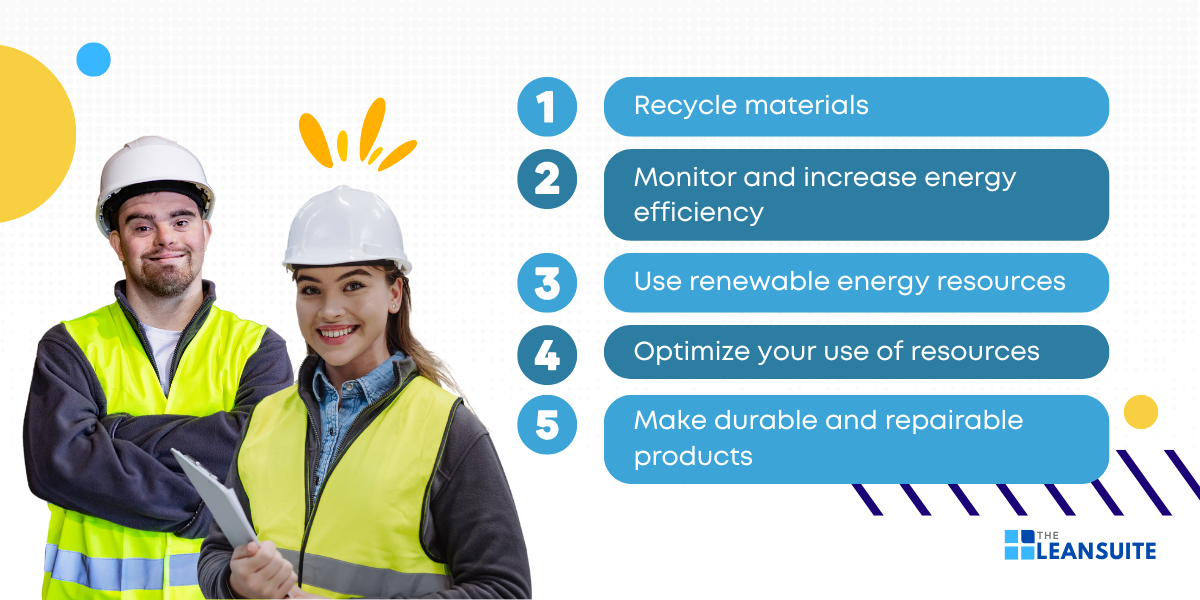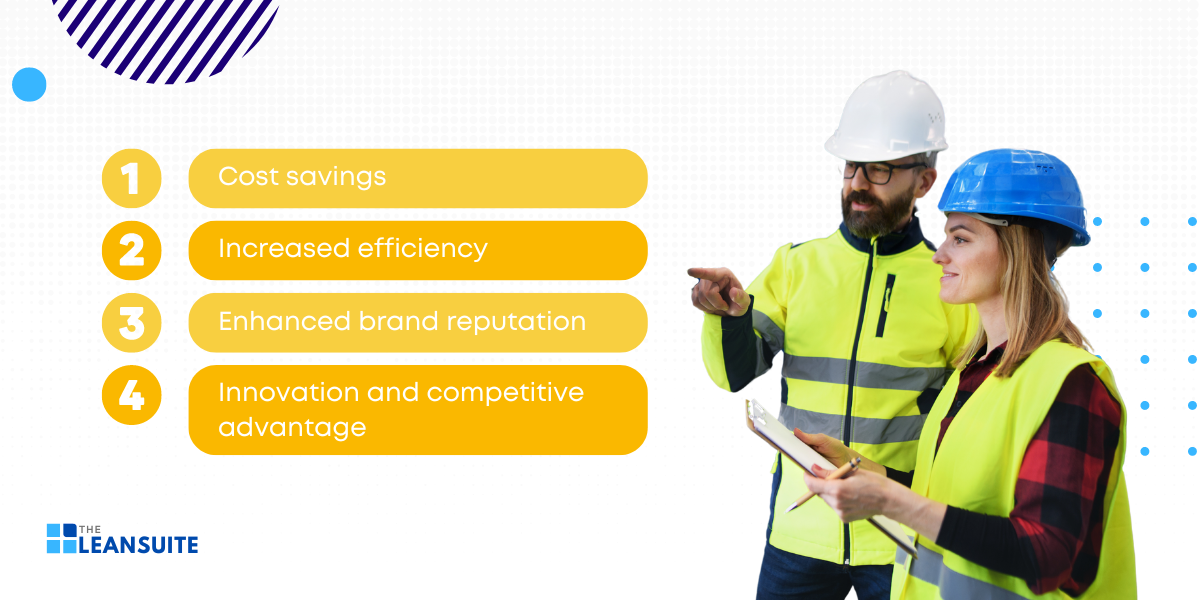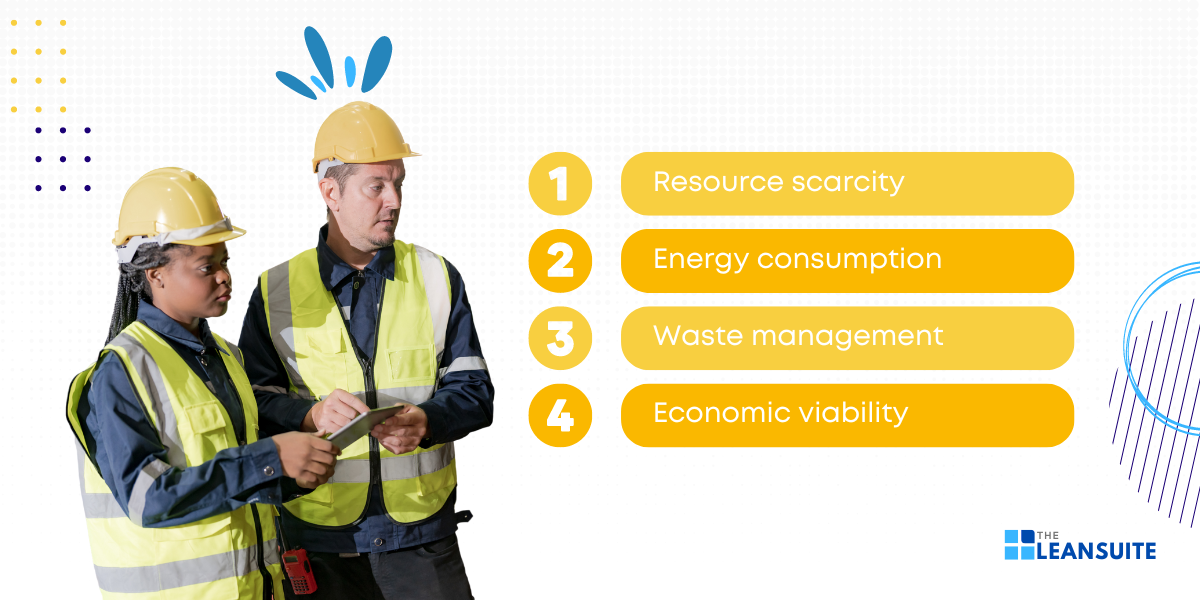In an era where environmental consciousness is increasingly becoming a priority, sustainable manufacturing stands out as an important solution for creating a healthier planet. This innovative approach to production not only aims to minimize waste and reduce carbon footprints, but also strives to balance economic growth with environmental stewardship.
By integrating eco-friendly practices and leveraging advanced technologies, sustainable manufacturing promises to transform traditional industries, making them more resilient and responsible. In this blog post, we will explore the benefits, challenges, and real-world applications of sustainable manufacturing.
What is sustainable manufacturing?
Sustainable manufacturing (also known as green manufacturing or eco-friendly manufacturing), is a goods production technique that aims to minimize negative environmental impacts while conserving energy and natural resources.
The main goal of sustainable manufacturing is to create manufactured products through economically sound processes that minimize negative environmental impacts while ensuring safety for employees, local communities, and the product itself.
Sustainable manufacturing includes processes that conserve energy and natural resources, minimize waste, and promote eco-friendly manufacturing practices. For instance, the use of renewable energy sources, waste reduction practices such as recycling and reusing materials, implementing efficient production techniques to reduce resource consumption, and designing products with longer life spans to reduce the frequency of replacement.
The importance of sustainable manufacturing
The main importance of sustainable manufacturing is the environmental benefits it brings.
Sustainable manufacturing is crucial in today’s world as it helps minimize negative environmental impacts and conserves energy and natural resources. What’s more, it reduces waste, pollution, and energy consumption. As a result, this leads to a more sustainable future.
By adopting sustainable business practices, companies can significantly reduce their carbon footprint, leading to a greener environment and promoting long-term ecological balance. This not only benefits the planet, but also enhances a company’s reputation, aligns with the growing consumer demand for environmentally responsible products, and often results in cost savings through improved efficiency and resource management.
Sustainable manufacturing best practices
Implementing various practical strategies to promote sustainability in your operations not only contributes to the broader sustainability effort, but also enhances the sustainability of your business success. Here are five best practices that you can adopt to promote sustainability:

1. Recycle materials
Recycling materials is the most basic, but also the most important sustainable business practice. It involves reprocessing waste or used materials into new products. Thereby, reducing the need for new resources.
By recycling metals, plastics, and other materials, you can significantly cut down on the energy and raw materials required for the production process. Additionally, recycling reduces waste sent to landfills, minimizing environmental pollution and conserving natural resources for future generations.
2. Monitor and increase energy efficiency
Monitoring and improving energy efficiency is crucial for reducing the environmental impact of manufacturing processes. For instance, this can be achieved by conducting regular energy audits, utilizing energy-efficient machinery, and optimizing production schedules to minimize energy consumption during peak demand periods.
Implementing energy management systems and real-time monitoring tools can help identify areas where energy is being wasted and offer solutions to reduce waste and enhance efficiency. Ultimately, this can help lower production costs and carbon footprints.
3. Use renewable energy sources
Utilizing renewable energy sources such as solar, wind, and hydroelectric power is a significant step towards sustainable manufacturing. These sources provide a cleaner alternative to fossil fuels, reducing greenhouse gas emissions and dependence on non-renewable resources.
You can invest in on-site renewable energy systems or purchase renewable energy credits to offset their energy usage. Transitioning to renewable energy not only supports environmental sustainability, but can also offer long-term cost savings and energy security.
4. Optimize your use of resources
Efficient resource utilization involves minimizing waste and maximizing the productivity of raw materials. Techniques such as Lean process management, also known as Lean manufacturing, which focuses on reducing waste and improving process efficiency, can be highly effective. Additionally, employing strategies like Just-In-Time inventory management ensures that resources are used only when needed.
5. Make durable and repairable products
Designing and manufacturing products that are durable and easy to repair extends their lifespan. This reduces the need for frequent replacements and thus, conserves resources. What’s more, this can be achieved by using high-quality materials, incorporating modular design principles that allow for easy part replacement, and providing comprehensive repair guides and services.
Business benefits of sustainable manufacturing
Sustainable manufacturing offers a multitude of benefits for your business, making it a strategic choice for long-term success. Here are four key advantages:

Cost savings
Implementing sustainable business processes often leads to significant cost reductions. By optimizing resource use, reducing waste, and improving energy efficiency, you can lower your operational expenses. For example, recycling materials and adopting energy-efficient technologies can decrease utility bills and raw material costs. As a result, this can lead to increased profitability.
Increased efficiency
Sustainable business practices often result in streamlined operations and improved efficiency. By optimizing resource use and reducing waste, companies can achieve higher productivity levels. Moreover, efficient use of resources can lead to faster production times, reduced downtime, and improved overall performance. This operational efficiency not only supports sustainability goals, but also enhances profitability and long-term growth.
Enhanced brand reputation
Consumers are increasingly favouring companies that demonstrate a commitment to environmental responsibility. Therefore, by implementing sustainable business practices, you can boost your company’s image and differentiate it from competitors. This, in turn, can attract environmentally conscious customers, foster customer loyalty, and open up new market opportunities.
Innovation and competitive advantage
Sustainable manufacturing encourages innovation by challenging you to develop new, efficient processes and products. This drive for continuous improvement can lead to the creation of cutting-edge technologies and solutions that provide a competitive edge. Businesses that prioritize sustainability are often seen as industry leaders, setting trends and attracting partnerships and investments that further enhance their market position.
Challenges of achieving sustainable manufacturing
While companies are beginning to acknowledge the influence of sustainability efforts on consumer behaviour and their significance in strengthening the brand’s image and reputation, there are still severals obstacles in implementing and achieving them.

Resource scarcity
One of the primary challenges of achieving sustainable manufacturing is the limited availability of sustainable resources. That is to say, many materials required for manufacturing are finite. In addition, the shift towards sustainable alternatives often means finding substitutes that are not only environmentally friendly, but also cost-effective and efficient. Therefore, this requires extensive research and development, as well as significant investment.
Energy consumption
Manufacturing production processes typically consume large amounts of energy, much of which is derived from non-renewable sources. So, transitioning to renewable energy sources such as solar, wind, or hydro power is crucial, but can be complex and costly. Additionally, manufacturing facilities must invest in energy-efficient technologies and practices to reduce overall consumption.
Waste management
The generation of waste, including hazardous materials, is a significant issue in the manufacturing sector. That’s why implementing effective waste management strategies, such as recycling and reusing materials, is essential for sustainability. However, this often involves redesigning processes, investing in new technologies, and training employees, which can be both time-consuming and expensive.
Economic viability
Balancing economic viability with environmental responsibility is a key challenge. Sustainable manufacturing often requires substantial upfront investments in new technologies, processes, and materials. This can be a barrier for many companies, especially small and medium-sized enterprises. Therefore, ensuring that these sustainable production practices are economically feasible in the long run is essential for widespread adoption.
Real-world examples of sustainable manufacturing
Companies like Roma Food Products and JD Sports are implementing sustainable manufacturing practices, including reducing waste and using renewable energy.
Roma Food Products
Roma Food Products is a leading plant-based, gluten and allergen-free food manufacturer in Australia. They prioritize sustainability by using a solar grid, reducing waste, recycling materials, and implementing energy-efficient machinery. What’s more, employees engage in eco-friendly practices like carpooling and using reusable containers. The company also collaborates with local farms for organic ingredients, aiming to set an industry benchmark for environmental responsibility and social consciousness.
JD Sports
JD Sports is a leading sneaker and sport fashion retailer. They implement sustainability initiatives like reducing plastic use, recycling waste water, and promoting renewable energy to reduce greenhouse gas emissions. These efforts aim to minimize plastic pollution, conserve water, and cut reliance on fossil fuels. The company also engages in community outreach and partnerships with environmental organizations to raise awareness and support conservation projects. By integrating sustainability into its business model, JD Sports hopes to inspire other retailers and meet the demands of eco-conscious consumers, showcasing that environmental responsibility and business success can coexist.





